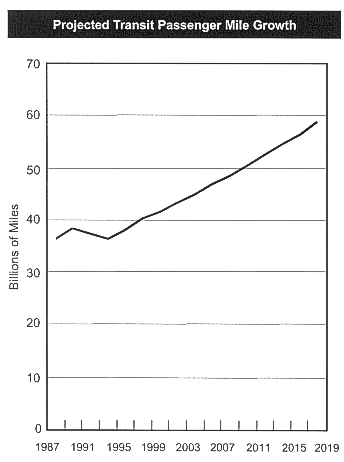U.S. Department of Transportation
Federal Highway Administration
1200 New Jersey Avenue, SE
Washington, DC 20590
202-366-4000
| |
| Conditions and Performance Report Executive Summary |
| Executive Summary Chapter Listing Conditions and Performance Home Page
|
|
The Transit Economic Requirements Model (TERM), from which the estimated transit investment requirements are obtained, is structured to accommodate transit passenger growth by adding more capacity, rather than actively affecting travel growth rates by improving service and lowering the user costs of transit riders. Projections of future transit travel growth are obtained from metropolitan planning organizations (MPOs) in large urbanized areas. The weighted average transit passenger mile growth rate of the most recently available forecasts is 1.9 percent. At this rate, total annual transit passenger miles in the U.S. would grow from 40.2 billion in 1997 to 58.7 billion in 2017.  |
Despite the estimated gap between funding and investment requirements, transit conditions and performance have been relatively stable over the past 10 years, with the exception of the Nation’s heavy rail vehicle fleet, which has shown significant aging and deterioration. One of the most important parameters used in estimating investment requirements is the annual growth rate in transit passenger miles, obtained from the MPO forecasts. In order to test the sensitivity of the estimated investment needs to the growth rate forecasts, investment needs were additionally estimated using three alternative growth rates: 2.85 percent (50 percent greater growth than forecast), 0.95 percent (50 percent less growth), and zero percent growth. Investment requirements under the Maintain Conditions and Performance scenario would be 20 percent larger under the higher growth rate, 18 percent smaller using the lower growth rate, and 35 percent smaller under zero passenger mile growth. Investment requirements under the Improve Conditions and Performance scenario are somewhat less sensitive to the growth rate than they are under the Maintain scenario. The most significant improvements made to TERM for this report were in the way it relates asset age to asset condition. Data on urban buses and urban bus maintenance facilities were obtained during the National Bus Condition Assessment, an effort aimed primarily at providing data to improve the statistical specification of asset deterioration over time. The new deterioration curves imply a more rapid decrease in bus condition in the early years of use, and a more gradual decline in condition over the remainder of the useful life of the vehicle. |